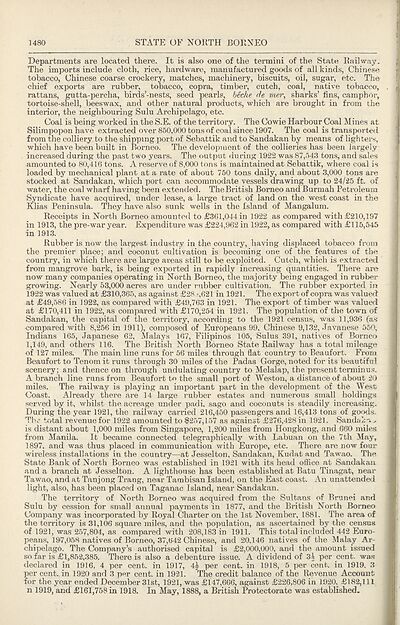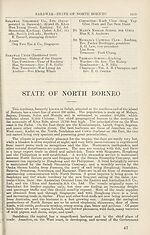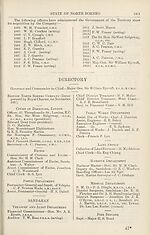1924
(1581) Page 1480
Download files
Complete book:
Individual page:
Thumbnail gallery: Grid view | List view

1480
STATE OF NORTH BORNEO
Departments are located there. It is also one of the termini of the State Railway.
The imports include cloth, rice, hardware, manufactured goods of all kinds, Chinese
tobacco, Chinese coarse crockery, matches, machinery, biscuits, oil, sugar, etc. The
chief exports are rubber, tobacco, copra, timber, cutch, coal, native tobacco,
rattans, gutta-percha, birds’-nests, seed pearls, beche <h mer, sharks’ fins, camphor,
tortoise-shell, beeswax, and other natural products, which are brought in from the
interior, the neighbouring Sulu Archipelago, etc.
Coal is being worked in the S.E. of the territory. The Cowie Harbour Coal Mines at
Silimpopon have extracted over 850,000 tons of coal since 1907. The coal is transported
from the colliery to the shipping port of Sebattik and to Sandakan by means of lighters,
which have been built in Borneo. The development of the collieries has been largely
increased during the past two years. The output during 1922 was 87,543 tons, and sales
amounted to 80,416 tons. A reserve of 8,000 tons is maintained at Sebattik, where coal is
loaded by mechanical plant at a rate of about 750 tons daily, and about 3,000 tons are
stocked at Sandakan, which port can accommodate vessels drawing up to 24/25 ft. of
water, the coal wharf having been extended. The British Borneo and Burmah Petroleum
Syndicate have acquired, under lease, a large tract of land on the west coast in the
Klias Peninsula. They have also sunk wells in the Island of Mangalum.
Receipts in North Borneo amounted to £361,044 in 1922 as compared with £210,197
in 1913, the pre-war year. Expenditure was £224,962 in 1922, as compared with £115,545
in 1913.
Rubber is now the largest industry in the country, having displaced tobacco from
the premier place; and coconut cultivation is becoming one of the features of the
country, in which there are large areas still to be exploited. Cutch, which is extracted
from mangrove bark, is being exported in rapidly increasing quantities. There are
now many companies operating in North Borneo, the majority being engaged in rubber-
growing. Nearly 53,000 acres are under rubber cultivation. The rubber exported in
1922 was valued at £310,365, as against £28 ?,621 in 1921. The export of copra was valued
at £49,586 in 1922, as compared with £49,763 in 1921. The export of timber was valued
at £170,411 in 1922, as compared with £170,254 in 1921. The population of the town of
Sandakan, the capital of the territory, according to the 1921 census, was 11,936 (as
compared with 8,256 in 1911), composed of Europeans 99, Chinese 9,132, Javanese 550,
Indians 165, Japanese 62, Malays 167, Filipinos 105, Sulus 391, natives of Borneo
1,149, and others 116. The British North Borneo State Railway has a total mileage
of 127 miles. The main line runs for 56 miles through flat country to Beaufort. From
Beaufort to Tenom it runs through 30 miles of the Padas Gorge, noted for its beautiful
scenery; and thence on through undulating country to Melalap, the present terminus.
A branch line runs from Beaufort to the small port of Weston, a distance of about 20
miles. The railway is playing an important part in the development of the West
Coast. Already there are 14 large rubber estates and numerous small holdings
served by it, whilst the acreage under padi, sago and coconuts is steadily increasing.
During the year 1921, the railway carried 216,450 passengers and 16,413 tons of goods.
The total revenue for 1922 amounted to $257,157 as against £276,428 in 1921. Sandal;-...
is distant about 1,000 miles from Singapore, 1,200 miles from Hongkong, and 660 miles
from Manila. It became connected telegraphically with Labuan on the 7th May,
1897, and was thus placed in communication with Europe, etc. There are now four
wireless installations in the country—at Jesselton, Sandakan, Kudat and Tawao. The
State Bank of North Borneo was established in 1921 with its head office .at Sandakan
and a branch at Jesselton. A lighthouse has been established at Batu Tinagat, near
Tawao, and at Tanjong Trang, near Tambisan Island, on the East coast. An unattended
light, also, has been placed on Taganac Island, near Sandakan.
The territory of North Borneo was acquired from the Sultans of Brunei and
Sulu by cession for small annual payments in 1877, and the British North Borneo
Company was incorporated by Royal Charter on the 1st November, 1881. The area of
the territory is 31,106 square miles, and the population, as ascertained by the census
of 1921, was 257,804, as compared with 208,183 in 1911. This total included 442 Euro¬
peans, 197,058 natives of Borneo, 37,642 Chinese, and 20,146 natives of the Malay Ar¬
chipelago. The Company’s authorised capital is £2,000,000, and the amount issued
so far is £1,852,385. There is also a debenture issue. A dividend of 3A per cent, was
declared in 1916, 4 per cent, in 1917, 4^ per cent, in 1918, 5 per cent, in 1919, 3
per cent., in 1920 and 3 per cent, in 1921. The credit balance of the Revenue Account
for the year ended December 31st, 1921, was £147,666, against £226,806 in 1920,. £182,111
n 1919, and £161,758 in 1918. In May, 1888, a British Protectorate was established.
STATE OF NORTH BORNEO
Departments are located there. It is also one of the termini of the State Railway.
The imports include cloth, rice, hardware, manufactured goods of all kinds, Chinese
tobacco, Chinese coarse crockery, matches, machinery, biscuits, oil, sugar, etc. The
chief exports are rubber, tobacco, copra, timber, cutch, coal, native tobacco,
rattans, gutta-percha, birds’-nests, seed pearls, beche <h mer, sharks’ fins, camphor,
tortoise-shell, beeswax, and other natural products, which are brought in from the
interior, the neighbouring Sulu Archipelago, etc.
Coal is being worked in the S.E. of the territory. The Cowie Harbour Coal Mines at
Silimpopon have extracted over 850,000 tons of coal since 1907. The coal is transported
from the colliery to the shipping port of Sebattik and to Sandakan by means of lighters,
which have been built in Borneo. The development of the collieries has been largely
increased during the past two years. The output during 1922 was 87,543 tons, and sales
amounted to 80,416 tons. A reserve of 8,000 tons is maintained at Sebattik, where coal is
loaded by mechanical plant at a rate of about 750 tons daily, and about 3,000 tons are
stocked at Sandakan, which port can accommodate vessels drawing up to 24/25 ft. of
water, the coal wharf having been extended. The British Borneo and Burmah Petroleum
Syndicate have acquired, under lease, a large tract of land on the west coast in the
Klias Peninsula. They have also sunk wells in the Island of Mangalum.
Receipts in North Borneo amounted to £361,044 in 1922 as compared with £210,197
in 1913, the pre-war year. Expenditure was £224,962 in 1922, as compared with £115,545
in 1913.
Rubber is now the largest industry in the country, having displaced tobacco from
the premier place; and coconut cultivation is becoming one of the features of the
country, in which there are large areas still to be exploited. Cutch, which is extracted
from mangrove bark, is being exported in rapidly increasing quantities. There are
now many companies operating in North Borneo, the majority being engaged in rubber-
growing. Nearly 53,000 acres are under rubber cultivation. The rubber exported in
1922 was valued at £310,365, as against £28 ?,621 in 1921. The export of copra was valued
at £49,586 in 1922, as compared with £49,763 in 1921. The export of timber was valued
at £170,411 in 1922, as compared with £170,254 in 1921. The population of the town of
Sandakan, the capital of the territory, according to the 1921 census, was 11,936 (as
compared with 8,256 in 1911), composed of Europeans 99, Chinese 9,132, Javanese 550,
Indians 165, Japanese 62, Malays 167, Filipinos 105, Sulus 391, natives of Borneo
1,149, and others 116. The British North Borneo State Railway has a total mileage
of 127 miles. The main line runs for 56 miles through flat country to Beaufort. From
Beaufort to Tenom it runs through 30 miles of the Padas Gorge, noted for its beautiful
scenery; and thence on through undulating country to Melalap, the present terminus.
A branch line runs from Beaufort to the small port of Weston, a distance of about 20
miles. The railway is playing an important part in the development of the West
Coast. Already there are 14 large rubber estates and numerous small holdings
served by it, whilst the acreage under padi, sago and coconuts is steadily increasing.
During the year 1921, the railway carried 216,450 passengers and 16,413 tons of goods.
The total revenue for 1922 amounted to $257,157 as against £276,428 in 1921. Sandal;-...
is distant about 1,000 miles from Singapore, 1,200 miles from Hongkong, and 660 miles
from Manila. It became connected telegraphically with Labuan on the 7th May,
1897, and was thus placed in communication with Europe, etc. There are now four
wireless installations in the country—at Jesselton, Sandakan, Kudat and Tawao. The
State Bank of North Borneo was established in 1921 with its head office .at Sandakan
and a branch at Jesselton. A lighthouse has been established at Batu Tinagat, near
Tawao, and at Tanjong Trang, near Tambisan Island, on the East coast. An unattended
light, also, has been placed on Taganac Island, near Sandakan.
The territory of North Borneo was acquired from the Sultans of Brunei and
Sulu by cession for small annual payments in 1877, and the British North Borneo
Company was incorporated by Royal Charter on the 1st November, 1881. The area of
the territory is 31,106 square miles, and the population, as ascertained by the census
of 1921, was 257,804, as compared with 208,183 in 1911. This total included 442 Euro¬
peans, 197,058 natives of Borneo, 37,642 Chinese, and 20,146 natives of the Malay Ar¬
chipelago. The Company’s authorised capital is £2,000,000, and the amount issued
so far is £1,852,385. There is also a debenture issue. A dividend of 3A per cent, was
declared in 1916, 4 per cent, in 1917, 4^ per cent, in 1918, 5 per cent, in 1919, 3
per cent., in 1920 and 3 per cent, in 1921. The credit balance of the Revenue Account
for the year ended December 31st, 1921, was £147,666, against £226,806 in 1920,. £182,111
n 1919, and £161,758 in 1918. In May, 1888, a British Protectorate was established.
Set display mode to:
![]() Universal Viewer |
Universal Viewer | ![]() Mirador |
Large image | Transcription
Mirador |
Large image | Transcription
Images and transcriptions on this page, including medium image downloads, may be used under the Creative Commons Attribution 4.0 International Licence unless otherwise stated. ![]()
| Asian directories and chronicles > 1924 > (1581) Page 1480 |
|---|
| Permanent URL | https://digital.nls.uk/196444466 |
|---|
| Attribution and copyright: |
|
|---|---|
| Description | Volumes from the Asian 'Directory and Chronicle' series covering 1917-1941, but missing 1919 and 1923. Compiled annually from a multiplicity of local sources and research. They provide listings of each country's active corporations, foreign residents and government agencies of all nationalities for that year, together with their addresses. Content includes: various treaties; coverage of conflicts; currencies and taxes; consular fees; weights and measures; public holidays; festivals and traditions. A source of information for both Western states and communities of foreigners living in Asia. Published by Hongkong Daily Press. |
|---|---|
| Shelfmark | H3.86.1303 |
| Additional NLS resources: |

